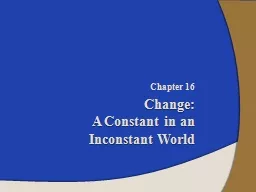PPT-Chapter 16
Author : giovanna-bartolotta | Published Date : 2016-05-11
Change A Constant in an Inconstant World Chapter 16 Objectives Identify who usually recommends and implements organizational changes Describe significant forces
Presentation Embed Code
Download Presentation
Download Presentation The PPT/PDF document "Chapter 16" is the property of its rightful owner. Permission is granted to download and print the materials on this website for personal, non-commercial use only, and to display it on your personal computer provided you do not modify the materials and that you retain all copyright notices contained in the materials. By downloading content from our website, you accept the terms of this agreement.
Chapter 16: Transcript
Download Rules Of Document
"Chapter 16"The content belongs to its owner. You may download and print it for personal use, without modification, and keep all copyright notices. By downloading, you agree to these terms.
Related Documents














